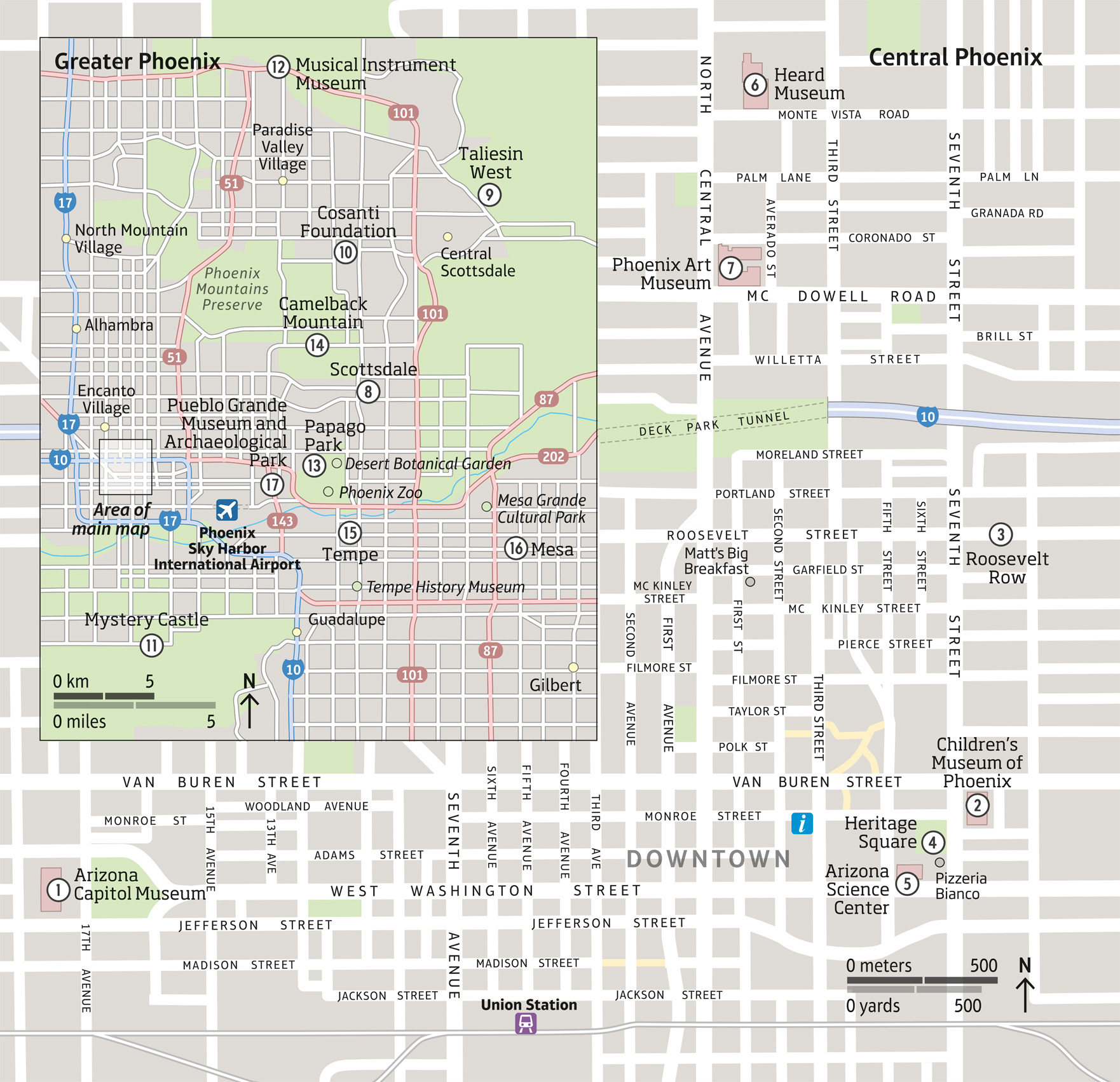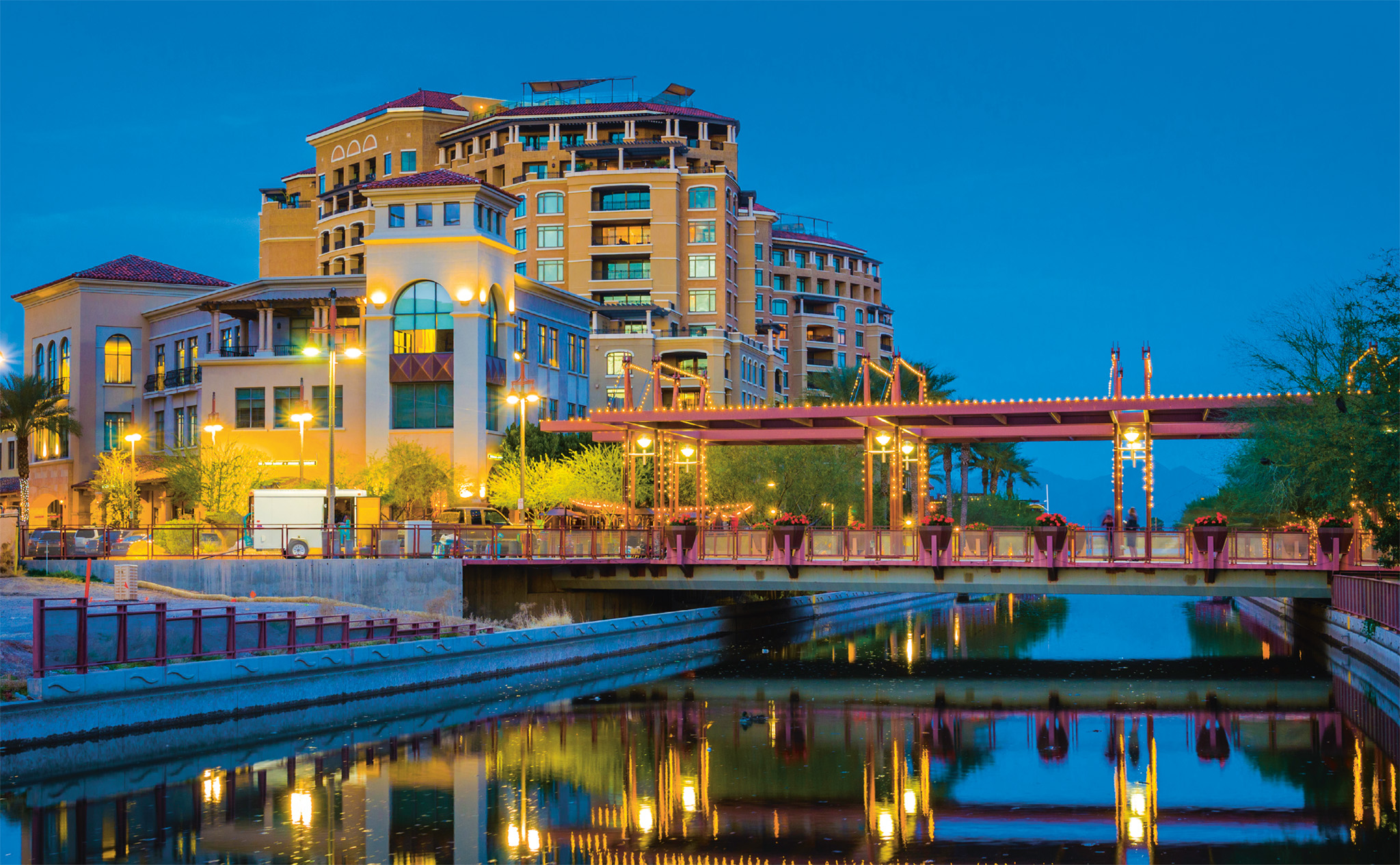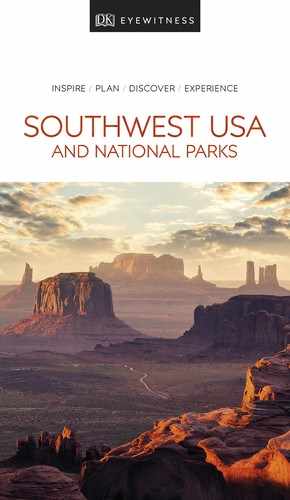Phoenix is a huge metropolis, stretching across the Salt River Valley. Farmers and ranchers settled here in the 1860s, and by 1912 the city had developed into the political and economic focus of Arizona, becoming the state capital. As it grew, it absorbed surrounding towns, although each district still maintains its identity. Downtown Phoenix is home to many historic attractions, including Heritage Square and the Heard Museum.

t Cityscape of downtown Phoenix against a mountain backdrop at dusk
Experience Phoenix and Southern Arizona

n Double-tap image to read the labels
Completed in 1900, the Arizona Capitol houses the legislative and executive branches of the state government, as well as the museum. Spread over four stories, the museum covers the region's political, social, economic, and cultural history using high-tech and traditional displays.
This is not so much a museum as a wonderful indoor play-ground designed for kids up to the age of ten. Kids can run, build, and learn freely in a safe environment. Highlights include hands-on art activities, a room designed for fort-building, and a forest made of bright green and orange noodles. There is a special area for children under three years of age.
Affectionately known as RoRo, this earthy arts district, which neighbors downtown Phoenix to the north, lies between 7th Avenue and 12th Street with Roosevelt Street at its heart. The formerly run-down houses and abandoned buildings have been transformed by artists into colorful galleries and studios. There are also a plethora of eateries, and you can find every kind of shop from chic to grungy. Stroll around and you’ll see vibrant murals at almost every turn (you can download a map from the website). Celebrities such as Billie Holliday and Marilyn Monroe compete for wall space with skeletons, rainbows, boxers, giant roosters, and all manner of graffiti. A great time to visit is during downtown’s First Friday Art Walk or RoRo’s Third Friday events (both open 6–11pm), when museums and galleries do not charge an entrance fee and stay open until late. These events include an arts market with local handmade crafts, Hot Box Galleries with art exhibitions by cutting-edge artists set in pop-up shipping containers, street performers, food stalls, and live music.
EXPERIENCE Phoenix and Southern Arizona
|
STAY The Wigwam Resort Opened in 1929, this sprawling adobe-and-timber complex is set in lush grounds and offers elegant suites and casitas. It also has a luxurious spa, four pools, three restaurants, two bars, and three championship golf courses. ⌂ 300 E Wigwam Blvd, Litchfield Park ∑ wigwamarizona.com \ |
Phoenix is a thoroughly modern city, which grew rapidly after World War II. Many of its older buildings did not survive this expansion. However, a few late 19th- and early 20th-century buildings remain, and the most interest-ing of these are found on tree-lined Heritage Square, which also has numerous cafés and restaurants, and makes for a pleasant stroll. Rosson House, a handsome wooden mansion on Monroe Street, dates from 1895 and has a wraparound veranda and distinctive hexagonal turret. Visitors may tour the house, which is furnished in period style (call 602 262-5070). Next door is the Burgess Carriage House, constructed in an expansive colonial style rare in the Southwest. The 1900 Silva House features exhibits detailing Arizona’s history.

t The striking modern facade of the popular Arizona Science Center
This ultramodern facility has over 300 interactive science exhibits, covering everything from physics and energy to the human body, spread over four levels. There is something for everyone here. The popular “All About Me” gallery on Level One focuses on human biology. Here, visitors can take a virtual-reality trip through the body. Level Three has “Forces of Nature,” where you can experience simulations of earthquake tremors, fierce hurricane winds, and the heat of a forest fire. There is also a large-screen cinema that is popular with children.
The Heard Museum was founded in 1929 by Dwight Heard, a wealthy rancher and businessman, who, with his wife, Maie, assembled an extraordinary collection of Native Southwestern American art in the 1920s. Several benefactors later added to the collection, including Senator Barry Goldwater of Arizona and the Fred Harvey Company, who donated their kachina dolls.
The museum’s wide-ranging collection contains more than 40,000 works, but the star attraction is its display of more than 500 kachina dolls. Additionally, the museum showcases baskets, pottery, textiles, and fine art, as well as sumptuous silverwork by the Navajo, Zuni, and Hopi peoples.

t Traditional Hopi kachina doll, typically carved from cottonwood roots
Did You Know?
In the Hopi tradition kachinas are the spirits of nature deities, animals, or ancestors.
The largest art museum in the Southwest US, the highly acclaimed Phoenix Art Museum has an enviable reputation for the quality of its temporary exhibitions. The equally impressive permanent collection includes more than 19,000 works of American, Asian, European, and Latin American art, as well as modern art, contemporary art, fashion, and photography galleries. Works from the 14th to 19th centuries form the European collection. The Asian galleries feature archaeological artifacts, sculptures, scrolls, and manuscripts. The large Latin American collection encompasses Colonial Spanish pieces, including furniture and decorative arts, as well as works by Mexican painters from the 18th to 20th centuries. The American collection has works by 18th- and 19th-century American artists, with a focus on painters connected to the Southwest. The exhibits here include first-rate work from the Taos art colony of the 1900s and Georgia O’Keeffe ( p213), who was the most distinguished member of the group, as well as works by Frederic Remington and Ernest Blumenschein.
EXPERIENCE Phoenix and Southern Arizona
|
Eat & Drink Pizzeria Bianco Foodies flock to this restaurant forthe gourmet pizza pies. A menu of salads and wood-fired pizzas incorporates local, seasonal ingredients such as fennel sausage and smoked mozzarella. ⌂ 623 E Adams St ∑ pizzeriabianco.com. \ Matt’s Big Breakfast Locals line up early to get into this excellent little diner with 1950s dinette tables and vintage artwork. The breakfast menu has only grain-fed meats, free-range eggs, and organic produce. ⌂ 825 N 1st St ¢ Dinner ∑ mattsbigbreakfast.com \ Vincent on Camelback A local favorite since 1986, Vincent’s offers inventive menus blending Southwestern ingredients with a Provençal flair in dishes such as duck confit with pommes Lyonnaise and citrus sauce. ⌂ 3930 E Camelback Rd ¢ Lunch; Sun & Mon ∑ vincentsoncamelback.com \ |
Exploring Metropolitan Phoenix
In addition to its urban population of 1.6 million, Phoenix has a burgeoning number of residents in its metropolitan area, totaling more than 4.7 million. The city fills the Salt River Valley, occupying more than 2,000 sq miles (5,180 sq km) of the Sonoran Desert. Metropolitan Phoenix includes the cities of Scottsdale with its golf courses and designer stores, Tempe, which is home to Arizona State University, and Mesa with its Hohokam legacy.

t Scottsdale Waterfront, with designer shops and restaurants, at dusk
Fashion, art, and the Old West come together in Scottsdale. Best known for its many golf courses – there are more than 200 in and around the city – Scottsdale is also replete with luxury hotels and spas, upscale shopping, and fine dining.
In the heart of downtown, where the city was founded in the late 19th century, is Old Town Scottsdale (Main Street between Scottsdale Road and Brown Avenue). Behind its frontier-style facades you can shop for everything from souvenirs to Western wear and jewelry. Main Street ends at the Scottsdale Civic Center Mall, a welcome respite of grass, trees, and public art. Within the grounds are the Scottsdale Historical Museum and the acclaimed Scottsdale Museum of Contemporary Art, both with changing exhibitions.
West of Scottsdale Road, Main Street is the hub of the Arts District, with fine art galleries. The Scottsdale ArtWalk takes place on Thursdays (7–9pm) along Main Street and Marshall Way. Here too is Western Spirit: Scottsdale’s Museum of the West. Its exhibitions highlight the past and present-day art and culture of the Old West.
To the north, there are more galleries as well as Native American crafts in the Fifth Avenue Shopping District. The Scottsdale Waterfront is a fashionable shopping and dining complex.
=
Scottsdale Historical Museum
⌂ 7333 E Scottsdale Mall # Sep–May ∑ scottsdalehistory.org
" ' =
Scottsdale Museum of Contemporary Art
⌂ 7374 2nd Street # 11am–5pm Tue & Wed, 11am–8pm Thu–Sat, noon–5pm Sun ∑ smoca.org
" =
Western Spirit: Scottsdale’s Museum of the West
⌂ 3830 N Marshall Way # 9:30am–5pm Tue–Sat, 11am–5pm Sun ∑ scottsdalemuseumwest.org
Did You Know?
Until 1884, Scottsdale was called Orangedale as it was considered the ideal place to grow citrus fruit.

t Equilibrium by Heloise Crista in the Taliesin West garden
Generally regarded as the greatest American architect of all time, Frank Lloyd Wright (1867–1959) established the 600-acre (240-ha) Taliesin West complex as a winter school for his students in 1937. Wright came to prominence in Chicago during the 1890s with a series of strikingly original houses designed in elegant, open-plan style. Although noted for his use of local materials such as desert rocks and earth, he also pioneered the use of precast concrete.
Taliesin West is approached along a winding desert road. The muted tones of the low-lying buildings reflect Wright’s enthusiasm for the desert setting. He was careful to enhance, rather than dominate, the landscape.
Today, Taliesin West is home to the School of Architecture at Taliesin and the Frank Lloyd Wright Foundation, where students live and work. There are a variety of tours that range from one to three hours. Ninety-minute tours begin every hour from 9am to 4pm. Online booking is strongly recommended.
Desert Spas
Phoenix and Scottsdale are famous for their fabulous spas. Many are situated within luxurious hotel-spa resorts, where a variety of day packages and treatments can be enjoyed. You can indulge in desert-inspired treatments that use natural Sonoran botanicals such as aloe vera; hot stone massages; red clay or creosote body wraps; and desert gem-stone rituals. Native American healing treatments are a specialty at the Aji Spa at Wild Horse Pass Resort & Spa (www.wildhorsepass.com).
In 1947, Italian architect Paolo Soleri (1919–2013) came to study at Taliesin West. Nine years later, he set up the Cosanti Foundation to further his investigations into what he termed “arcology”: a combination of architecture and ecology to create new urban habitats. Today, the Cosanti site consists of simple, low structures housing studios, a gallery, and work-shops. Many are built below ground level and covered with mounds of earth for natural insulation. The workers make and sell their trademark wind bells. Self-guided walking tours are available, but guided tours are by reservation only.
Mystery Castle is possibly Phoenix’s most eccentric attraction. In 1927, Boyce Luther Gulley came to Phoenix from Seattle hoping that the warm climate would improve his ailing health. His daughter had loved building sand castles on the beach, and since Phoenix was so far away from the ocean, Gulley created a real-life fairy-tale sandcastle for her. He started work in 1930 and continued until his death in 1945. Discarded bricks and scrapyard junk, including old car parts, have been used to build the structure. The 18-room interior can be seen on a guided tour, which explores the quirky building and its eclectic collection of antiques and furniture.
